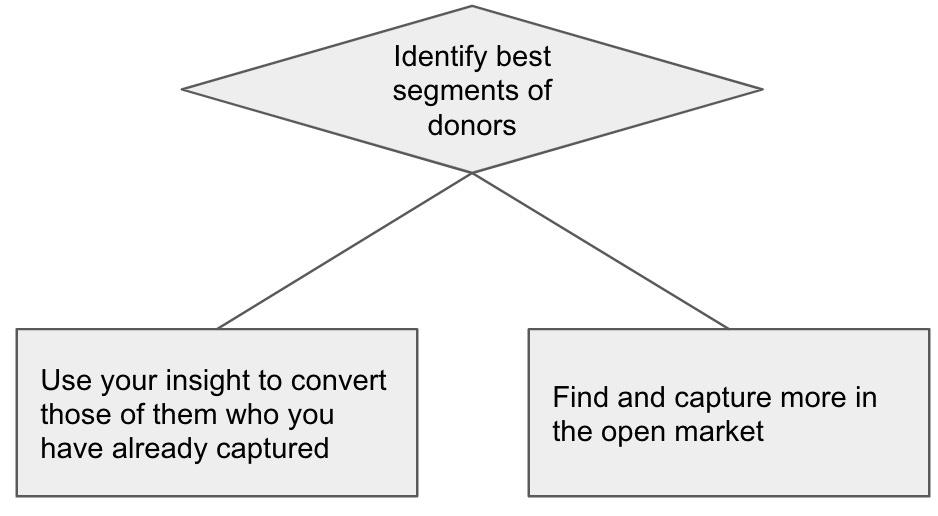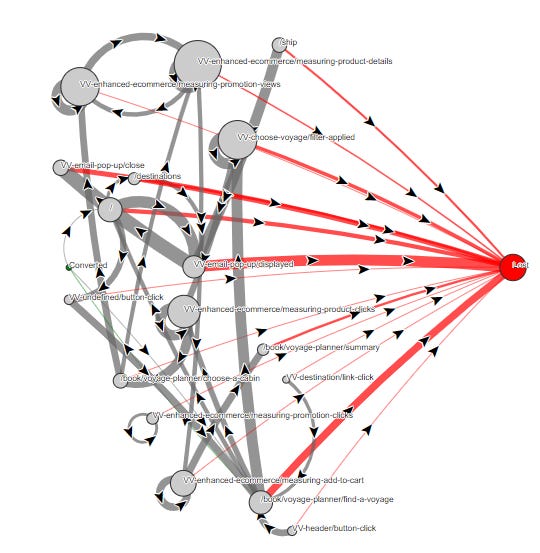Some Personal News
#15 Identifying Donors with the Highest Potential to Convert, Donor Experience, Your Growth Strategy
Happy Sunday. A very warm welcome to all the new subscribers. I’m thrilled to have you as readers and truly appreciate your feedback and support. In this edition we’ll get into the following:
Identifying donors with the highest potential to convert
Bad web experiences
Re-thinking your growth strategy
If you don’t find this content valuable, you can permanently unsubscribe at the bottom of this email. If you like it, subscribe and don’t miss the weekly post:
Let’s dig in!
News to Peruse
Most of you aren’t leaving Twitter, poll results show.
Instagram added the ability to add music to still image posts, providing another way to integrate music into the IG experience.
Google rolled out target frequency for YouTube campaigns.
TikTok published a new overview of key steps to take and improve the performance of your TikTok ads, starting with the data you share for targeting audiences in the app, to adjusting ad groups after launch to refine focus.
YouTube announced an expansion of its Comment Translation Tools, along with broader access to Smart Replies (its streamlined, template response option), which makes it easier to quickly engage with donors in the app.
Also, Meta launched a free 10 hour course on “What is the Metaverse?”
How to Identify the Highest Potential Segments to Convert
Before I answer the “How”, let me noodle on the “Why” for a moment. When 1st party data became a buzzword in the industry a few years ago, an agency friend and I spent a few hours discussing the actual value and the hyped-up BS. We landed on agreeing that 1st party is beneficial when used in the following cycle:
Collecting and integrating online donor journey’s
(optional) Adding in offline data and integrating it
Enriching it with 2nd party qualifiers to better describe our best donors
Segmenting it to identify our best donors – while considering the population size, share of wallet, and other parameters outside of purely our data
Prioritizing segments based on available budget and the anticipated value each segment can bring
Going to the open market and finding more people like it
Run media targeting prospects knowing it’s only one part of the broader play which includes solid bidding strategies, inventory exclusions, and 827 other daily optimizations we need to make
Measuring the impact of an increase in high-value donors on file
The above cycle is a must-happen for every non-profit to grow.
NB. Bullet #6 holds a secret - it’s a split-point that looks like the below diagram:
In earlier editions of Some Personal News, I’ve shared my “Engagement Progression” matrix, and the “Master Segmentation Table” that I use to identify top donor segments from Google Analytics in-market and affinity reports:
The use cases for these tables were finding the best prospective cash and monthly pledge donors. When using it to find new donors, that level of segmentation is enough – we need to cast a wide-enough net and can’t be overly restrictive.
But we can go one step further when looking for those we want to retarget now to convert immediately.
Audience qualifiers answer whether the person “is” likely to become a donor. They don’t, however, answer “when” they will. What does? Their current depth of engagement. I use content they consumed on the website as the best predictor of their current stage. As a result I developed a “Content Engagement Index” (CEI) to be able to predict upstream Conversion Rate upstream. Here’s an example of what one looks like, intentionally not specific to any non-profit.
To save you from doing too much zooming in and out, let me break it down and then show you how to implement something similar this using your Google Analytics (GA) data.
CEI is a singular metric ranging from 1 to 100 meant to identify the website's low- and high-performing content, which then allows me to identify successful initiatives earlier in the cycle and speed up the decision-making process.
Based on GA data, I’m collecting signals at a User, Session, Page, and Hit level. I then combine these unique “user trajectories” (illustrated above) into a comprehensive summary allowing me to analyze behaviors at scale across segments.
Practically CEI helps me determine whether a person is likely to convert in their next interaction or if they need 2-3 more touches (and therefore more time) to convert based on how deep they got in their last interaction.
Switching to GA, here is what the basic implementation would look like:
After identifying 4-5 top segments and creating the master table, create the “segments” in GA with those definitions – at a User scope:
Use the “Behavior Flow” report for each of those specific segments:
Look for 2nd and 3rd interaction. Usually, patterns are emerging – which pages are they visiting? Are there specific pillars they are interested in? Have they checked the “Journey of a Dollar” or “About” pages?
Across 4-5 top user segments, the target is to identify 1 page that is the deepest in their website interactions – usually it’ll be a Content Pillar page or a content-heavy page explaining how the donation would be spent by your non-profit.
Once those 4-5 sub-segments are identified, compare them in sizes and select the top 3 largest so you can effectively target them in Google Ads.
The next step you already know – create three audiences, combining the Audience definition and the Page they have already viewed at the user scope:
Once that audience is pushed to Google Ads, I’d usually use it for both the Display retargeting campaigns (with the creative connection to the content pillar identified) and for RLSA (retargeting lists for search ads) for every donation-related broad match keyword to avoid these prospects from switching to any of my competitors.
The above approach is helpful when run at least once a week. It takes no more than 30 minutes – but immensely and immediately helps you identify patterns and quickly course-correct to convert most prospects. And that is especially needed during this end-of-year fundraising period!
Finally, you should start noticing patterns as you build this cadence over time. Which pages are more likely to convert immediately? Which ones require 5+ sessions? That is the starting point for the “advanced” CEI implementation, which I’ll dig more into in another edition. The goal here is to incorporate content analytics into your predicted lifetime value – AND start working with your website teams to start building out converting content beyond donation landing pages. In my experience, this approach has been much more productive than any focus groups or heat-map analytics plug-in tool.
Experience Matters
One of the biggest mistakes I see Digital Marketing and Fundraising teams make is not stopping every once in a while and asking the question - Does this make sense?
We need to do a better job of understanding donor experience and where people are in the donor journey.
As a first time visitor to two non-profit sites this past week, before I even got to read the headline…
I encountered at least 3 if not 4 pop-ups
2 of which were asking for a donation (after 0 time on site)
And, in one case, two of the CTA’s in the pop-ups were exactly the same
I can only imagine the impact this is having on bounce rates and time on site. Note to self: instead of hammering everyone to convert the second they hit the site consider the below.
Remember that not all traffic is the same! Make an effort to understand the different types of visitors and build experiences for them (paid / organic / blog traffic / return visitors vs new, etc).
If I just clicked “Donate” from an ad then by all means take me to a page built around conversions. If I’m a first time visitor coming from a generic search then the experience should be built around brand exploration, not aggressive CTA’s.
Look to add value and be a place prospective donors can explore and learn more about your mission or problem you solve.
Go through your donor experience regularly from landing on the site all the way through to sign-up and donate (if it feels painful to you imagine how it feels to new users).
Marketer's don't set out to build experiences like this but it often happens over time when we’re not constantly monitoring the experience we’re providing. I dare you to visit your site this week and ask yourself the question - Does this make sense?
“Predictably Unpredictable”
Metrics are not about repeatability. They are about probability.
For illustrative purposes, let's say you have a 10% visitor-to-donation conversion rate from an ad campaign.
That figure doesn’t tell you that you'll get 1 donation out of every 10 visitors. It says that your ad targeting and messaging has a 10% probability of resonating.
People who visit your landing page are not numbers that have to conform to a certain statistic. They are people, with real emotions and thoughts, and they can act unpredictably.
Just as some people can get a long winning streak in casino games that are obviously probabilistically rigged against them, you can get unpredictable results from month to month on your growth channels.
The nuance is subtle, but it leads to a huge mindset shift.
Note this for your EOY forecasting: If you increase your advertising budget from $100k to $200k, it's highly likely that your conversion rate will change, simply because you change the sample size. Usually, the conversion rate dips as you increase your budget because ad platforms are smart with prioritizing impressions to people that are likely to donate.
Don’t base your growth strategy around doing more of what you currently do. It will fail. You have to keep reinventing and broadening. You should also keep in mind that those User IDs you see on your analytics dashboard are real humans with complex and often ever-changing needs and emotions.
Metrics are about probability.
Interesting Reads This Week:
When you do brand right - it’s not instead of search, it drives search. Need more case studies and data that tie brand strength to growth and business KPIs … this is great h/t AirBnB
The latest Dentsu Media Trends report - always worth reading (big themes – Content, Commerce and Community).
How AudioMob revolutionized audio advertising.
Advertising isn’t funny anymore, but does that mean ads are more effective?
Fascinating thread in Twitter: “I think most people who are not playing with these technologies are way underestimating the speed of advancement in "creative" AI.
A database of growth ideas and channels from top founders and growth leaders.
Digital Marketing and Fundraising Jobs:
Amnesty International: Head of Digital Engagement
Comic Relief: Director of Fundraising
Crisis UK: Digital Product Officer
Diabetes UK: Digital Product Owner
Freedom From Torture: Head of Digital Mobilization & Engagement
Global Commons: Head of Fundraising Development
Pancreatic Cancer UK: Digital Marketing Officer
Sierra Club: Senior Managing Director, Digital Fundraising & Advertising
UK for UNHCR: Senior Officer, Direct and Digital Marketing
With You: Head of Brand and Digital
Thank you for reading Some Personal News.
If you enjoyed this, please consider sharing with a friend. If a friend sent you this, get the next newsletter by signing up.
How could I help you? I use my experience, expertise and network to help mission-driven organizations solve interesting problems and grow.
See you next week!








